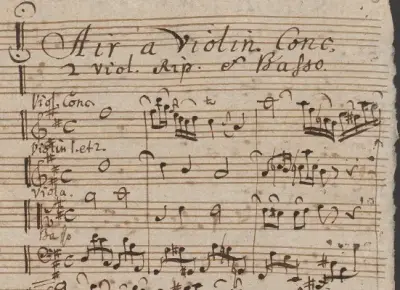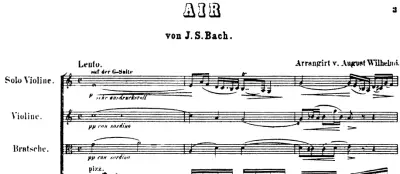Download a PDF of the sheet music + TAB of a classical guitar arrangement of Air on the G String by Bach.
Air on the G String by Bach
History of the Air
 The so-called “Air on the G String” is just called “Air” by Bach in the original. The full title is “Air a Violin conc. 2 viol. Rip. et Basso.” Air is simply an Anglicized version of the Italian “aria,” and so typically means a song-like instrumental piece.
The so-called “Air on the G String” is just called “Air” by Bach in the original. The full title is “Air a Violin conc. 2 viol. Rip. et Basso.” Air is simply an Anglicized version of the Italian “aria,” and so typically means a song-like instrumental piece.
The Air is the second movement of Bach’s Orchestral Suite No.3 (BWV 1068), composed around 1730. The autograph manuscript score has parts for solo violin, violins 1 and 2, viola, and bass.
Arrangement for “the G String” by Wilhelmj
 This air became particularly popular after an arrangement by violinist August Wilhelmj in 1871. Wilhelmj took the original from its home key of D Major down to C Major and placed the melody of the solo violin part entirely on the lowest, fourth-string G. Thus the piece took on the name “Air on the G String.”
This air became particularly popular after an arrangement by violinist August Wilhelmj in 1871. Wilhelmj took the original from its home key of D Major down to C Major and placed the melody of the solo violin part entirely on the lowest, fourth-string G. Thus the piece took on the name “Air on the G String.”
Air on the G String for Guitar
Challenges of arranging
Bringing Bach’s music to the guitar always presents certain challenges. He writes in polyphony, sometimes with up to four voices at once, and this is difficult to play well on the guitar. But taking a work written for orchestra, even for the reduced strings and continuo of this air, is even more challenging still. At the end of the day, the arranger must make compromises and some things cannot be carried forward from the original to its new instrument.
But we can still play the essence of this music. And there are two distinct features that stand out the most: the beautiful soaring melody, and the steady pulsing bass line. So the arrangement below features those two primary voices throughout. Other voices tend only to enter at moments where not as much is happening in these two voices (usually at cadences).
Our arrangement
Because this music is so iconic, we have provided you with an easy version that removes many of the challenges of the original. This “easy” version (probably Grade 5) is in the guitar friendly key of C Major, the same as Wilhelmj’s. You’ll notice a consistent steady descending bassline. This is different from how the bass moves in the original, where it jumps around up an octave and back each measure.
Performance Notes
Ornaments
Please note there are many ornaments written into the original music along with ornament signs. (Go here to learn more about ornamentation in the music of J.S. Bach.) We have removed all ornament signs, but we’ll point out the places you could add them back if you’re a more advanced player. We have also taken the liberty of writing out all appoggiaturas from the original into rhythmic notation. This gives you more precision for how to perform the ornaments. Often players distort the rhythms when ornaments are involved.
Measure 3, beat 3 has an appoggiatura on the D in the upper voice. Rhythmically it should be played as a sixteenth note or faster. We have spelled that out in the example below. You may omit this if you prefer (as we have done in our edition).
At measure 4, the A on beat 3 is an appoggiatura in the original. If you prefer to play this as a slur, from A to the open G, you may. There are many opportunities to add slurs throughout this piece, in fact. We have not added any so you might explore some on your own.
Here are original trill signs added back in. Please note that how you perform the trill (left-hand slurs or cross-string trills) will change the fingering you need to use.


Beat 4 of measure 36 is a place where all baroque performers would have added a trill. You might explore adding a trill from the C to the B on the second string with left-hand slurs.

Long durations
The first-string E that begins the melody will die out before it can resonate for its two-plus full bars. For that reason, you can choose to re-pluck the note at the beginning of the second measure.
The low F on the sixth string in measure 2 is quite challenging to play on beat 2 because of the stretch needed to reach the high A. If the stretch is too much for you, you could simply play a rest on beat 2. Another option is to use a capo on the second fret, which will slightly reduce the stretch. This also puts the music back in its original key of D Major.

The A on the first string in measure 23 should sustain for three full beats in the original. To do so requires a different fingering than that provided. Here’s how to do that:

Barre
If the barre at measure 32 is too difficult for you, an alternative fingering that works is the following:


Thank you for sharing this wonderful piece of music and especially the insight into the piece.
Such a lovely arrangement!
Another reason to keep working my way toward level five!
Thank you very much.
Thank you for sharing this
Thanks!
Really fantastic..
Thank you for sharing this beautiful jewelry, days ago I was searching for the score and luckily you shared a very beautiful, manageable version.
Will definitely learn to play.
So beautifully played!
Amazing performance, thank you for the download. I will give it a try.
simon,
are you playing with a Paul Sheridan lattice braced or Garrett Lee double top?
thanks,
Hi Vincent,
In this video Simon is playing his Garrett Lee double top.
Peace,
Dave B (CGC team)